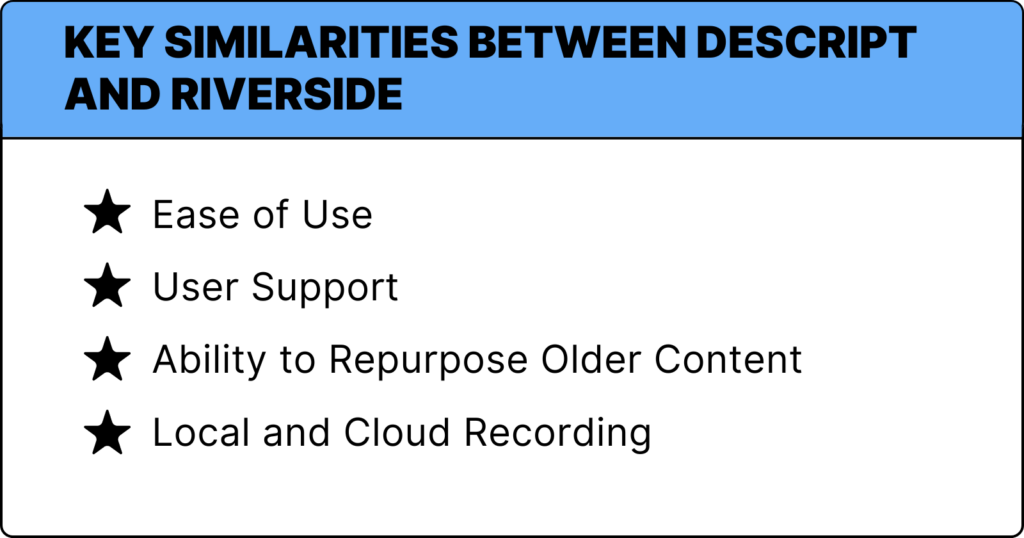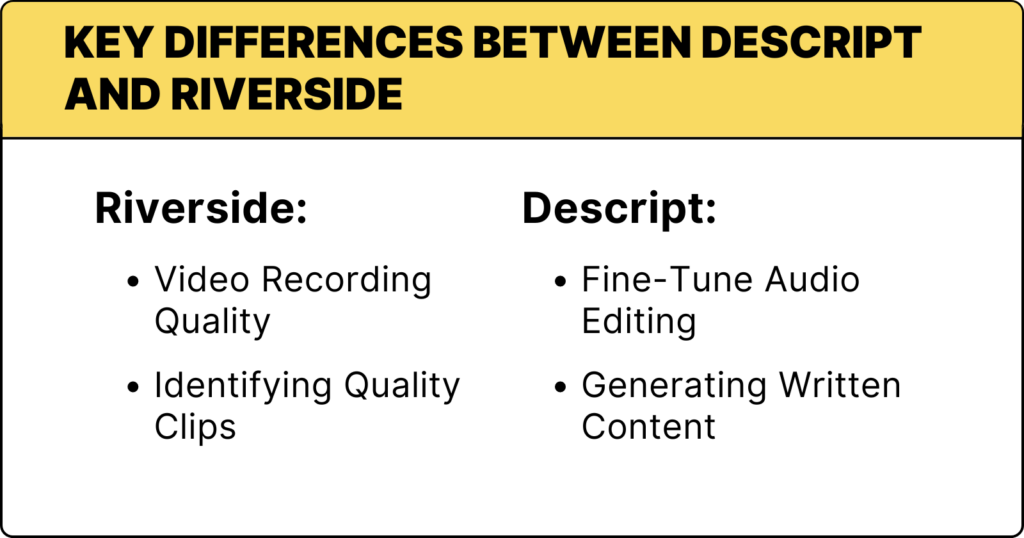Recording, editing, and sharing high-quality video and audio is easier than ever for content marketers. We have multiple web-based platforms available that are affordable, intuitive, and flexible enough for most content needs. But which tool should you rely on, and why? In this competition, the main event these days is Descript vs. Riverside.
While video’s importance for content creation has skyrocketed in the past couple of years, many marketers trained in text or images are still getting used to the idea. Perhaps that’s why only 7% of marketers told Content Marketing Institute that they’re using video to its full potential — even though 67% say video has become more important.
The good news is that you don’t suddenly have to become a one-person production team. Great multimedia producers are still essential. The difference is that tools like Riverside and Descript are helping marketers across roles get more involved in the recording, editing, and distributing of video and audio content.
We sat down with Rep Cap’s own Michael Thibodeaux, Multimedia Producer, and Grace McGrath, Assistant Multimedia Producer, to learn more about the key differences and similarities between the two and which we’d recommend for your needs.

Key Similarities Between Descript and Riverside
Ease of Use
One of the key similarities between Riverside and Descript is the user-friendly nature of both platforms. They’re designed to be accessible even to those without extensive technical knowledge, which you immediately notice thanks to each platform’s straightforward, jargon-less terminology. This contrasts sharply with more complex post-production systems like Adobe, where users might need to learn platform-specific lingo and navigate more complicated interfaces.
The two platforms have also streamlined the editing process. During production, you can mark clips during the recording, as well as control the recording’s quality by adjusting both audio and video settings for each participant.
For post-production editing, you can edit the video/audio right next to an AI-generated transcript. This feature is particularly beneficial as it saves time you’d otherwise spend rewatching entire recordings to locate specific segments. As Grace mentions, “The biggest benefit that I’m finding is how much easier it is to go back and find the clips that you’re looking for.” This capability helps you identify the best content quickly, making content creation much more efficient.
Riverside takes the lead in streamlining the entire process into one platform. With Riverside, you can record, review, and edit all in one software. When using Descript, on the other hand, the recording takes place on its partner platform, Squadcast, and is then sent over to Descript for post-production editing.
User Support
Both Riverside and Descript are noted for their strong customer and community support, which enhances the user experience significantly. As production workflows continue to evolve with advancements in AI, both platforms continue to enhance their capabilities to fit users’ needs.
In addition, both Riverside and Descript have helpful online communities that you can turn to for advice or solutions to specific obstacles. Michael mentions that employees from both platforms are active within online communities, such as Facebook and Reddit. These employees actively engage with users, answering questions and discussing new features. This level of interaction not only helps in resolving specific user issues but also fosters a sense of community and belonging among their customers. Their proactive approach to customer engagement plays a crucial role in encouraging the exploration of new platform features.
Ability to Repurpose Older Content
Riverside and Descript offer powerful features that allow you to repurpose old video and audio effectively, enhancing the value and lifespan of previously captured content. You can upload older recordings, such as webinars, podcast episodes, or customer testimonials, and edit them using the platform’s full suite of tools.
Both platforms allow you to review and edit the recording alongside a transcript. This feature alone makes it easier to identify the content to repurpose. Both Riverside and Descript also allow editors to cut clips from the recording and export them as new content. This works well for creating promo videos for social media use or fine-tuning a client testimonial before adding it to a webpage. The ease of extracting valuable segments from past recordings can simplify the content creation process, making it easier for you to refresh and redistribute older content in new, engaging formats.
Local and Cloud Recording
Riverside and Squadcast (Descript’s partner) prioritize high-quality recording by combining local and cloud recording. They capture each participant’s audio and video locally on their own devices, which helps prevent any interruptions from poor internet connectivity. This makes either platform ideal for podcasters, interviewers, and content creators who require reliable and high-quality remote recording solutions.

Key Differences Between Descript and Riverside
Video Recording Quality
Riverside is particularly praised for its video recording quality compared to other remote recording software. The platform supports up to 4K video resolution, making it an excellent choice for professionals who require superior video clarity. In addition, Riverside provides you with more control during the recording process. Producers and hosts can customize the session, with the option to add branding or music to the recording.
Another helpful feature during the recording process is the ability for users to mark clips live. When an important moment happens during the recording, users can mark that spot in the recording with a click of a button. Then, during post-production editing, those markers help editors find the exact moment they’re looking for.
Fine-Tune Audio Editing
Descript allows for more fine-tuned audio editing, giving users more control and flexibility. One of the standout features of Descript is its “Studio Sound” capability, which allows you to enhance audio quality with just a click. This AI feature is particularly useful for improving recordings with background noise or poor sound quality. Rather than a basic noise reduction process, this tool identifies the speaker’s specific audio and isolates it so you can enhance the speaker while reducing echo or background noise. You can adjust the level of noise reduction, providing flexibility over the audio output. In contrast, noise reduction isn’t as finely tunable in Riverside, where the audio enhancement is more of an all-or-nothing approach.
Additionally, Descript supports advanced audio editing features that go beyond basic enhancements. For instance, you can easily cut and rearrange audio clips within a user-friendly interface, making the editing process more efficient and less technical. Descript also offers the “Overdub” tool, which lets you generate voiceovers using AI. These generated voiceovers can, with prior consent, mimic specific voices, which is incredibly useful for creating consistent audio outputs or making corrections without needing to re-record audio. These features collectively make Descript a powerful tool for both novice and experienced audio editors who need robust, flexible, and intuitive audio editing capabilities.
Identifying Quality Clips
Riverside, while perhaps not as advanced in AI-driven content creation as Descript, still offers significant capabilities in handling older content. You can upload old videos to Riverside, where you can easily extract high-quality clips using one of Riverside’s key AI features, “Magic Clips.” The tool automatically identifies and cuts the best clips from the recording, pulling out the content that matters and giving you or your editors a helpful jump start.
While Descript’s AI can also identify content from the recording, the generated results aren’t always as reliable. Michael notes that it often suggests irrelevant content, such as basic introductions, which aren’t useful for creating engaging clips. He finds Riverside more effective at selecting clips that have a real impact.
Generating Written Content
Descript’s current AI writing gives it an edge over Riverside. Descript can automatically generate YouTube descriptions, show notes, and blog post topics from an existing video or audio transcript. You can also ask Descript’s AI to identify key moments or good clips, although those results may vary. This ability to extract key moments and create various forms of content from a single source makes Descript particularly valuable for content repurposing.
While Riverside doesn’t offer a wide variety of written AI content, it does offer AI-generated show notes based on the auto-generated transcript for the recording.
Developing a Post-Production Workflow That Works for You
Now that you know the similarities and differences between each platform, do you go with Riverside or Descript? Or is there a secret third (or fourth, or fifth) option for you to keep in mind?
The Case for Riverside
If you’re primarily focused on recording and video editing, we recommend you go with Riverside. The platform’s video editing features surpass what’s available within Descript, making your task much easier. Its Magic Clips feature will also come in handy when you know you recorded the perfect response for a social media clip.
Going With Descript
On the other hand, if you need to focus on the audio quality of your recording, or if you’d prefer higher-quality AI recommendations and written assets associated with your recording, Descript will be your best friend. Descript’s Overdub feature is also a huge help if you ever find that a few words didn’t come out clearly in the audio and you need a re-recording.
Secret Third Option: Using Them Together
We’ll let you in on a secret: Sometimes, we’ve actually used both Riverside and Descript together. Sometimes, it can get a bit messy jumping from platform to platform, and it definitely requires more communication, but because each platform has features that you cannot get in the other, and they both have their own strengths, it doesn’t hurt to combine the two. You can definitely adopt a video editing strategy that employs Riverside for crisp video and enticing social media posts while utilizing Descript for sound editing and written content.
Other Post-Production Editing Software
As already noted, Adobe Premier can be difficult to use if you’re new to the tool and aren’t as familiar with the video editing jargon. However, it’s still a very robust tool, and you can use it to add additional audio, such as sound effects and background music. Premier is also helpful for overlaying graphics, adding transitions, and more.
If Premier isn’t the right tool for you, though, Grace adds, “If you’re looking for a lower budget, much easier-to-use platform to do those things, Canva has gotten pretty good with that.” Canva is more easily accessible and doesn’t require as much training as Premier, so content teams can quickly jump in and start using it rather than needing some ramp-up time.
Riverside vs. Descript: Either Way, Video Is Here to Stay
So what is the best video recording software? That completely depends on your company and its needs. Regardless of your choice, video is a content format that won’t be going away any time soon.
And while you may not be a one-person video production team, the best platform for your company, whether Descript vs Riverside or another option, will be the one that helps you best create and distribute engaging videos for your audience.
Looking for more insights like these? Sign up for our LinkedIn newsletter.






